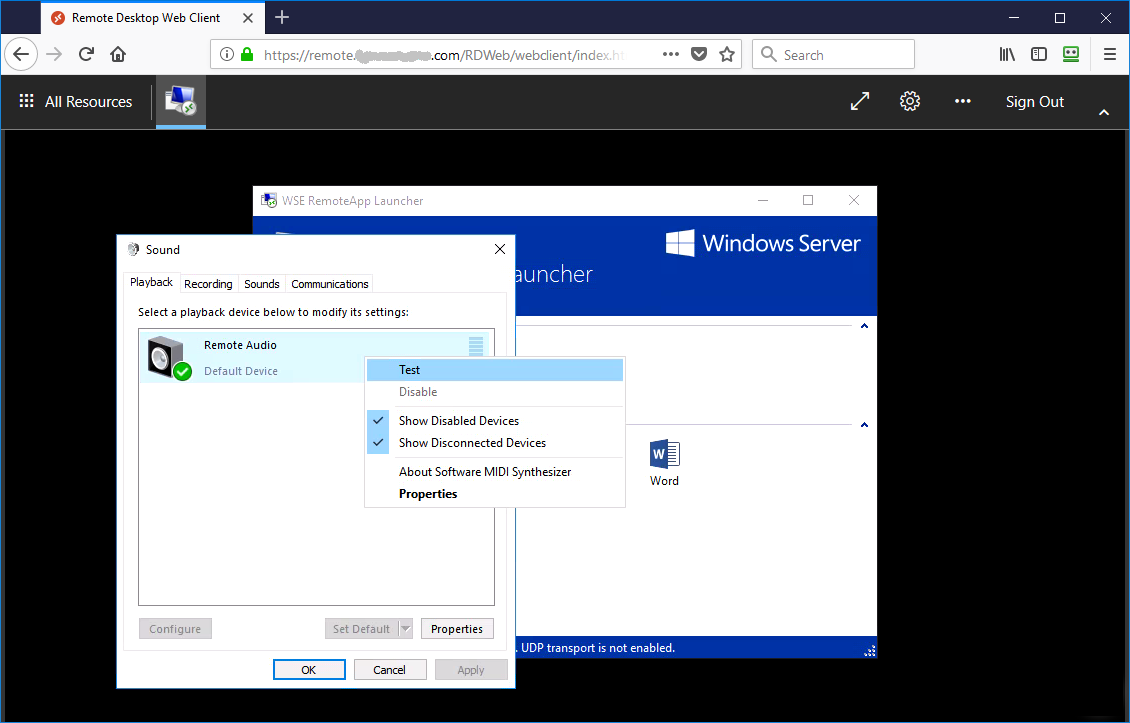Use Remote Desktop on your Windows, Android, or iOS device to connect to a Windows 10 PC from afar.
- Microsoft Remote Desktop Web
- Microsoft Remote Desktop Services Web Access
- Microsoft Remote Desktop Web Access Login
CloseDirectX End-User Runtime Web Installer On the Windows PC you want to connect to remotely, download the Microsoft Remote Desktop assistant to configure your PC for remote access. NOTE: To use RD Web Access, client computers must be running at least Internet Explorer 6.0 and a version of Remote Desktop Connection (RDC) that supports at least Remote Desktop Protocol (RDP) 6.1. NOTE: RD Web Access requires Internet Explorer 6.0 or later.

Set up the PC you want to connect to so it allows remote connections:
Make sure you have Windows 10 Pro. To check, go to Start > Settings > System > About and look for Edition. For info on how to get it, go to Upgrade Windows 10 Home to Windows 10 Pro.
When you're ready, select Start > Settings > System > Remote Desktop, and turn on Enable Remote Desktop.
Make note of the name of this PC under How to connect to this PC. You'll need this later.
Use Remote Desktop to connect to the PC you set up:
On your local Windows 10 PC: In the search box on the taskbar, type Remote Desktop Connection, and then select Remote Desktop Connection. In Remote Desktop Connection, type the name of the PC you want to connect to (from Step 1), and then select Connect.
On your Windows, Android, or iOS device: Open the Remote Desktop app (available for free from Microsoft Store, Google Play, and the Mac App Store), and add the name of the PC that you want to connect to (from Step 1). Select the remote PC name that you added, and then wait for the connection to complete.

The Remote Desktop Services Web Access Control supports the publishing of user-specific resources in RemoteApp and Desktop Connection. This control is a wrapper around the Remote Desktop Connection client (MsTscAx.dll) and the RemoteApp and Desktop Connections runtime proxy (Tswbprxy.exe).
In this section
Microsoft Remote Desktop Web
Exposes properties that launch the Remote Desktop Connection client from Remote Desktop Web Access (RD Web Access) or from other web portals.
Microsoft Remote Desktop Services Web Access

Microsoft Remote Desktop Web Access Login
Exposes methods that manage RemoteApp and Desktop Connection credentials and connections.

Set up the PC you want to connect to so it allows remote connections:
Make sure you have Windows 10 Pro. To check, go to Start > Settings > System > About and look for Edition. For info on how to get it, go to Upgrade Windows 10 Home to Windows 10 Pro.
When you're ready, select Start > Settings > System > Remote Desktop, and turn on Enable Remote Desktop.
Make note of the name of this PC under How to connect to this PC. You'll need this later.
Use Remote Desktop to connect to the PC you set up:
On your local Windows 10 PC: In the search box on the taskbar, type Remote Desktop Connection, and then select Remote Desktop Connection. In Remote Desktop Connection, type the name of the PC you want to connect to (from Step 1), and then select Connect.
On your Windows, Android, or iOS device: Open the Remote Desktop app (available for free from Microsoft Store, Google Play, and the Mac App Store), and add the name of the PC that you want to connect to (from Step 1). Select the remote PC name that you added, and then wait for the connection to complete.
The Remote Desktop Services Web Access Control supports the publishing of user-specific resources in RemoteApp and Desktop Connection. This control is a wrapper around the Remote Desktop Connection client (MsTscAx.dll) and the RemoteApp and Desktop Connections runtime proxy (Tswbprxy.exe).
In this section
Microsoft Remote Desktop Web
Exposes properties that launch the Remote Desktop Connection client from Remote Desktop Web Access (RD Web Access) or from other web portals.
Microsoft Remote Desktop Services Web Access
Microsoft Remote Desktop Web Access Login
Exposes methods that manage RemoteApp and Desktop Connection credentials and connections.
Exposes a method that associates RemoteApp and Desktop Connection credentials with a connection.

